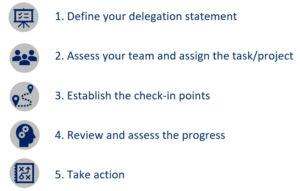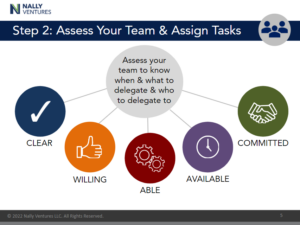
Delegation undaunted in 5 steps: Steps 1 & 2—Define, Assess, Assign
Delegation becomes much less daunting when you approach it systematically.
Delegation is one leadership essential that many leaders struggle with. We looked at some of the reasons leaders avoid delegation and how to reframe that negative mindset in our previous post here. Now let’s talk about a 5-step process to help you stop hesitating and start delegating confidently.

Step 1: Define your delegation statement.
Before you can delegate, you need to fully understand just what you are asking of someone. That means defining the task, the conditions, and the standard.
- Tasks are clearly defined, measurable activities that contribute to accomplishing larger, encompassing goals. For each task, you should know what needs to be done and the desired outcome.
- Conditions are the circumstances and environment in which the task it to be performed. So, how much time and money are available? What resources/information are needed? What challenges may exist? What are the expectations?
- Standards are the minimum acceptable level for success according to the delegator. What is the desired outcome, and how will you, the delegator, define and measure success?
One of the reasons people hesitate to delegate is that they aren’t clear on these factors. There may be tasks you don’t know a lot about, but you still have to delegate. When this is the case, you need to either gather information yourself, ask a subject matter expert on your team, ask someone on your team to research it, or otherwise get what you need to completely define your delegation statement.
Step 2: Assess your team and assign the task/project.
To succeed you have to delegate. But first you have to assess your team so you know when, what, and to whom you can delegate. Here’s an effective technique to use with teams or individuals.

- Clear – Are they clear on the objective?
- Willing – Are they willing to do what it takes to get the job done? Will they complete each task and reach each milestone of the project?
- Able – Do they have the skill sets and know-how?
- Available – Do they have the time? Are they here and present? Full-time, part-time, vacation, leave?
- Committed – Do they have the discipline to commit to each task? Do you trust them to do the right thing?
As you assess your team:
- Evaluate and validate your initial assumptions.
- Assess and position mindsets and skill sets the best you can.
- Make sure the individual/team can be successful at their job and (if applicable) work together as a team.
- Choose the best available person—someone with the best tools, knowledge, and experience.
Asking yourself these questions can uncover blind spots, and your responses will help you identify a clear path forward. Maybe delegation isn’t the next step—but if it is, our next post will take you through Steps 3 to 5 to close the loop.
How can we help your leaders and business excel?
